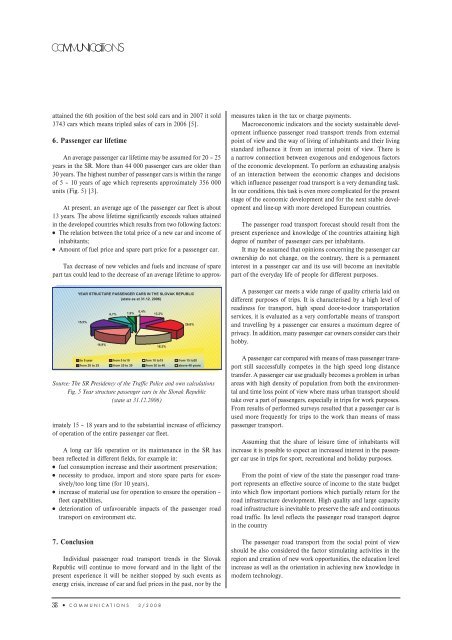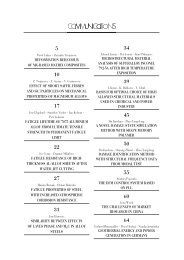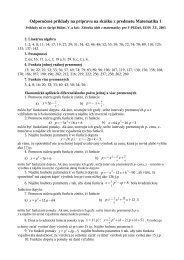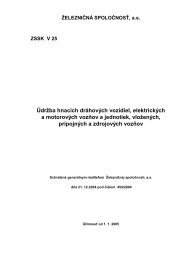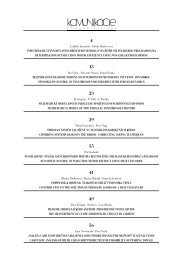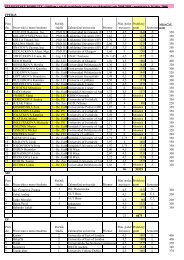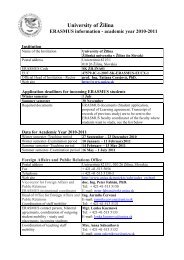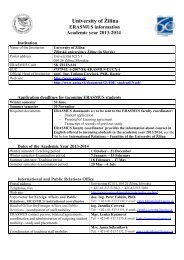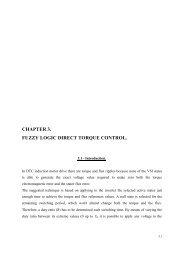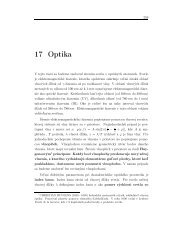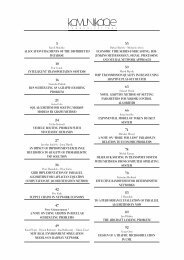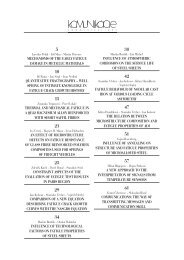simulation of torsion moment at the wheel set of the railway vehicle ...
simulation of torsion moment at the wheel set of the railway vehicle ...
simulation of torsion moment at the wheel set of the railway vehicle ...
Create successful ePaper yourself
Turn your PDF publications into a flip-book with our unique Google optimized e-Paper software.
<strong>at</strong>tained <strong>the</strong> 6th position <strong>of</strong> <strong>the</strong> best sold cars and in 2007 it sold3743 cars which means tripled sales <strong>of</strong> cars in 2006 [5].6. Passenger car lifetimeAn average passenger car lifetime may be assumed for 20 – 25years in <strong>the</strong> SR. More than 44 000 passenger cars are older than30 years. The highest number <strong>of</strong> passenger cars is within <strong>the</strong> range<strong>of</strong> 5 – 10 years <strong>of</strong> age which represents approxim<strong>at</strong>ely 356 000units (Fig. 5) [3].At present, an average age <strong>of</strong> <strong>the</strong> passenger car fleet is about13 years. The above lifetime significantly exceeds values <strong>at</strong>tainedin <strong>the</strong> developed countries which results from two following factors:● The rel<strong>at</strong>ion between <strong>the</strong> total price <strong>of</strong> a new car and income <strong>of</strong>inhabitants;● Amount <strong>of</strong> fuel price and spare part price for a passenger car.measures taken in <strong>the</strong> tax or charge payments.Macroeconomic indic<strong>at</strong>ors and <strong>the</strong> society sustainable developmentinfluence passenger road transport trends from externalpoint <strong>of</strong> view and <strong>the</strong> way <strong>of</strong> living <strong>of</strong> inhabitants and <strong>the</strong>ir livingstandard influence it from an internal point <strong>of</strong> view. There isa narrow connection between exogenous and endogenous factors<strong>of</strong> <strong>the</strong> economic development. To perform an exhausting analysis<strong>of</strong> an interaction between <strong>the</strong> economic changes and decisionswhich influence passenger road transport is a very demanding task.In our conditions, this task is even more complic<strong>at</strong>ed for <strong>the</strong> presentstage <strong>of</strong> <strong>the</strong> economic development and for <strong>the</strong> next stable developmentand line-up with more developed European countries.The passenger road transport forecast should result from <strong>the</strong>present experience and knowledge <strong>of</strong> <strong>the</strong> countries <strong>at</strong>taining highdegree <strong>of</strong> number <strong>of</strong> passenger cars per inhabitants.It may be assumed th<strong>at</strong> opinions concerning <strong>the</strong> passenger carownership do not change, on <strong>the</strong> contrary, <strong>the</strong>re is a permanentinterest in a passenger car and its use will become an inevitablepart <strong>of</strong> <strong>the</strong> everyday life <strong>of</strong> people for different purposes.A passenger car meets a wide range <strong>of</strong> quality criteria laid ondifferent purposes <strong>of</strong> trips. It is characterised by a high level <strong>of</strong>readiness for transport, high speed door-to-door transport<strong>at</strong>ionservices, it is evalu<strong>at</strong>ed as a very comfortable means <strong>of</strong> transportand travelling by a passenger car ensures a maximum degree <strong>of</strong>privacy. In addition, many passenger car owners consider cars <strong>the</strong>irhobby.Source: The SR Presidency <strong>of</strong> <strong>the</strong> Traffic Police and own calcul<strong>at</strong>ionsFig. 5 Year structure passenger cars in <strong>the</strong> Slovak Republic(st<strong>at</strong>e <strong>at</strong> 31.12.2006)Tax decrease <strong>of</strong> new <strong>vehicle</strong>s and fuels and increase <strong>of</strong> sparepart tax could lead to <strong>the</strong> decrease <strong>of</strong> an average lifetime to approxim<strong>at</strong>ely15 – 18 years and to <strong>the</strong> substantial increase <strong>of</strong> efficiency<strong>of</strong> oper<strong>at</strong>ion <strong>of</strong> <strong>the</strong> entire passenger car fleet.A long car life oper<strong>at</strong>ion or its maintenance in <strong>the</strong> SR hasbeen reflected in different fields, for example in:● fuel consumption increase and <strong>the</strong>ir assortment preserv<strong>at</strong>ion;● necessity to produce, import and store spare parts for excessively/toolong time (for 10 years),● increase <strong>of</strong> m<strong>at</strong>erial use for oper<strong>at</strong>ion to ensure <strong>the</strong> oper<strong>at</strong>ion –fleet capabilities,● deterior<strong>at</strong>ion <strong>of</strong> unfavourable impacts <strong>of</strong> <strong>the</strong> passenger roadtransport on environment etc.7. ConclusionIndividual passenger road transport trends in <strong>the</strong> SlovakRepublic will continue to move forward and in <strong>the</strong> light <strong>of</strong> <strong>the</strong>present experience it will be nei<strong>the</strong>r stopped by such events asenergy crisis, increase <strong>of</strong> car and fuel prices in <strong>the</strong> past, nor by <strong>the</strong>A passenger car compared with means <strong>of</strong> mass passenger transportstill successfully competes in <strong>the</strong> high speed long distancetransfer. A passenger car use gradually becomes a problem in urbanareas with high density <strong>of</strong> popul<strong>at</strong>ion from both <strong>the</strong> environmentaland time loss point <strong>of</strong> view where mass urban transport shouldtake over a part <strong>of</strong> passengers, especially in trips for work purposes.From results <strong>of</strong> performed surveys resulted th<strong>at</strong> a passenger car isused more frequently for trips to <strong>the</strong> work than means <strong>of</strong> masspassenger transport.Assuming th<strong>at</strong> <strong>the</strong> share <strong>of</strong> leisure time <strong>of</strong> inhabitants willincrease it is possible to expect an increased interest in <strong>the</strong> passengercar use in trips for sport, recre<strong>at</strong>ional and holiday purposes.From <strong>the</strong> point <strong>of</strong> view <strong>of</strong> <strong>the</strong> st<strong>at</strong>e <strong>the</strong> passenger road transportrepresents an effective source <strong>of</strong> income to <strong>the</strong> st<strong>at</strong>e budgetinto which flow important portions which partially return for <strong>the</strong>road infrastructure development. High quality and large capacityroad infrastructure is inevitable to preserve <strong>the</strong> safe and continuousroad traffic. Its level reflects <strong>the</strong> passenger road transport degreein <strong>the</strong> countryThe passenger road transport from <strong>the</strong> social point <strong>of</strong> viewshould be also considered <strong>the</strong> factor stimul<strong>at</strong>ing activities in <strong>the</strong>region and cre<strong>at</strong>ion <strong>of</strong> new work opportunities, <strong>the</strong> educ<strong>at</strong>ion levelincrease as well as <strong>the</strong> orient<strong>at</strong>ion in achieving new knowledge inmodern technology.38 ● COMMUNICATIONS 3/2008


